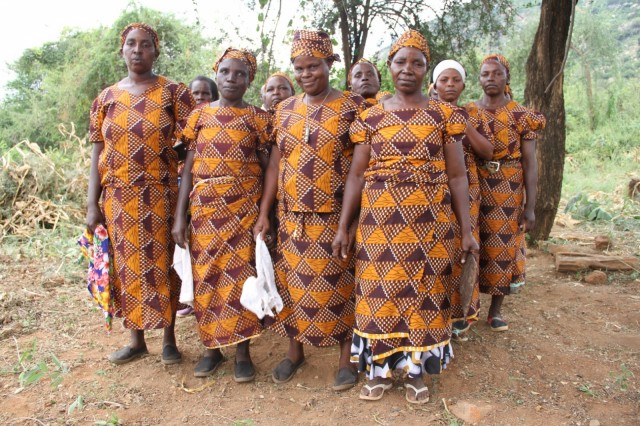Bantu Peoples
The Bantu, a large group of related peoples, originated along what is now the border between NIGERIA and CAMEROON and spread throughout central and southern Africa. The term Bantu is sometimes used to describe all Africans and African culture in general. But this use of the term is inaccurate; Bantu peoples make up only about a third of Africa's population. Bantu is also the name of the family of related LANGUAGES spoken by these people. Over time, the many Bantu-speaking peoples have become very different from one another.
Bantu Origins
All Bantu languages arose from a single language known as proto-Bantu. About 4000 B.C. the people who spoke this language developed a culture based on the farming of root crops, foraging, and fishing on the West African coast. Over the years, Bantu became more widely spoken than the languages of the nomadic peoples who lived in the same area. Its spread was probably aided by the unique social organization of the early Bantu, based on a system of cooperation between villages. Every village consisted of several “Houses,” and each House formed working relationships with Houses from other villages. This strong but flexible social network may have helped the Bantu migrate across the continent.

According to archaeological evidence, the Bantu migration began sometime after 3000 B.C. One group of Bantu moved southward, reaching southern Cameroon by about 1500 B.C. Within a thousand years the migrants also settled the coast of Congo and the Congo Basin in what is now the Democratic Republic of Congo (CONGO (KINSHASA)). These West Bantu people developed new skills such as ironworking and the making of ceramics. They continued to live side-by-side with other peoples, but apparently shared little in the way of culture or technology. The Interlacustrine Bantu. Long after the West Bantu migration, a second Bantu migration began—this one toward the east. Sometime before 1000 B.C. Bantu groups arrived in the northwestern Great Lakes area in what is now UGANDA. Known as the Interlacustrine Bantu, these peoples learned new farming methods from neighbors in eastern Africa who spoke Cushitic and Sudanic languages. They raised livestock—particularly cattle—and practiced agriculture, growing grain crops such as sorghum. Bantu women eventually married Sudanic and Cushitic men and raised their children to speak the Bantu language. Between about 500 B.C. and A.D. 800, the Bantu language spread throughout the Great Lakes region.
Two specific developments brought steady prosperity to this region after A.D. 1000. The first was the emergence of plantain farming. The second was pastoralism—a way of life in which cattle were driven from place to place in search of new grazing land. Both plantains (a bananalike fruit) and cattle produced a reliable year-round supply of food, enabling communities to grow in size and complexity. The Bantu founded new settlements, created a new style of pottery, and developed new social and political ties.
Bantu communities that practiced pastoralism were particularly influential in the area. Their cattle were a source of moveable wealth. People who owned cattle gained political power by loaning the cattle to neighbors, who were obligated to provide support and assistance to the lender in return. In this way, loaning cattle forged new political relationships and incorporated outsiders in existing political and social groups.
Bantu herding communities also spread their religion as they traveled, introducing new spirits and beliefs into the communities they visited. Their mediums established new centers of spiritual and political power that competed with and often replaced the worship of local spirits. Between 1000 and 1500 the new forms of economic, political, religious, and social life that arose under Bantu influence completely transformed Africa's Great Lakes region.
Later Bantu Cultures
The Interlacustrine Bantu eventually spread east to modern-day KENYA and TANZANIA and south into the present-day countries of ZIMBABWE, BOTSWANA, MOZAMBIQUE, and parts of SOUTH AFRICA. This movement was very rapid and most likely occurred before 200 B.C. As in the west, Bantu languages scattered widely throughout eastern Africa. After the first eastern expansion ended, East Bantu speakers in southeastern Congo (Kinshasa) and ZAMBIA moved westward and joined with West Bantu speakers. The languages in this area show a mixture of East and West Bantu influences.
The most extensive archeological evidence of Bantu culture in eastern and southern Africa dates from about A.D. 400. By this time, cattle were so important in southern Bantu society that villages were erected around a central pen. In Kenya the first towns built by the SWAHILI—another Bantu people—appeared around 750. Swahili settlements soon dotted the Indian Ocean coast as far south as Mozambique. Around the same time, systems of farming and herding arose in Uganda and RWANDA. These regions featured Bantu settlements with fortified central areas that eventually grew into kingdoms after about 1500.
By A.D. 1000, settlements along the Limpopo River had developed into a town called Mapungabwe—the capital of a Bantu kingdom that controlled much of the surrounding territory. After Mapungabwe declined, it was replaced around 1250 by the kingdom of Great Zimbabwe. This powerful empire flourished for almost 200 years by supplying gold and ivory to Swahili traders from the North. Bantu civilizations continued to dominate south and east Africa politically until European colonial governments displaced them in the 1800s. Today, the Bantu peoples are as diverse as the land they inhabit.
Hundreds of societies in central and southern Africa trace their roots to the Bantu, and about 150 million Africans speak one of nearly 600 Bantu languages. Yet regional differences in environment, livelihood, and history have made each Bantu society and tongue unique. The Bantu languages are so distinct that people who speak one language usually cannot understand their neighbors who speak another. Bantu patterns of social organization, forms of government, and ways of tracing KINSHIP vary widely. (See also Colonialism in Africa, Ethnic Groups and Identity, Livestock Grazing.)